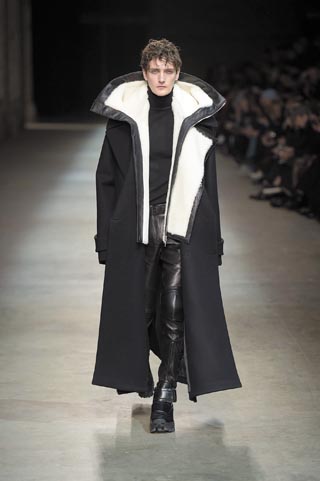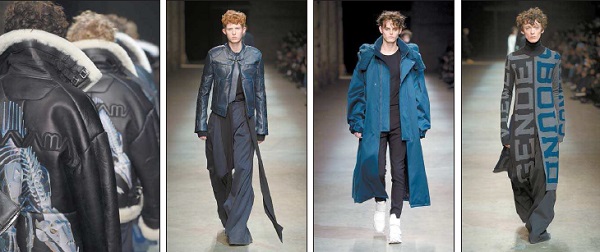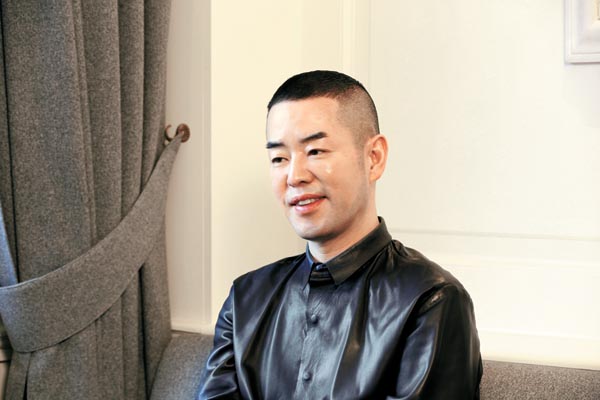A Korean brand’s Italian debut

At the 89th edition of Pitti Uomo, a global men’s fashion convention that started in 1972, designer Jung Wook-jun of Juun.J was the sole guest designer invited to present a fashion show.

Models present creations from the Korean fashion label Juun.J’s 2016 fall/winter collection earlier this month at the Pitti Uomo fair in Florence, Italy. The unique combination of Eastern and Western styles generated praise from the audience. [SAMSUNG C&T]
The designer’s 2016 fall/winter collection for Juun.J, which is owned by Samsung C&T, was refreshing and shocking to the extent that it was hard to explain in a few sentences.

Juun.J designer Jung Wook-jun [SAMSUNG C&T]
Black, white and cream were the main colors, with blue and gold as accent colors.
Korean-inspired elements like long, trailing belts resembling those of hanbok (Korean traditional costume), wide pants, scarves long enough to touch the floor, wide hoods that cover the shoulders, and patterns of large letters inspired spectators to call out, “Bellissimo!”
The JoongAng Sunday sat down with the designer after the show earlier this month to hear how he felt about his first show in Italy.
Q. How did it feel to be chosen as the guest designer for Pitti Uomo?
A. I first heard it when my PR agent told me last October. Pitti Uomo, a major event regarding menswear, is a center of global attention. It was an honor for me because only the one who is chosen as a guest designer by the organizing committee is allowed to host a show, while all designers open their shows during the Paris collection period.
It was your first show in Italy. Did you prepare a special collection dedicated to Pitti Uomo?
The concept for the 2016 fall/winter collection was already set. But I thought more suits were needed for Pitti Uomo, so I prepared them in addition.
Did you give up a Paris show for Pitti Uomo?
I think one show for one collection is enough. I will prepare a Paris show again from next season.
What is the theme for this collection?
“Less” is the theme. I could find several keywords from it such as “genderless,” “boundary-less,” “formless,” etc. I did not want to set limitations on my design - therefore, male, female, volume and size remained unrestricted and undefined.
Between trends and the identity of Juun.J, which do you value more when you are preparing a new collection?
Basically, the brand identity is more important. However, designers should have antennas for predicting the future. I can naturally predict the trend and what consumers will want for the next season. I would say that I carefully observe street fashion styles and social phenomena and use such information later to make clothes at the right time.
What factor do you think made your finale impressive?
Most designers have models wear the last look they wore and walk the stage again, but Juun.J dresses the models in looks it wants to highlight for the finale. It is the distinctive tradition of Juun.J that became its brand identity. I think finale is the new start, which makes me continue this tradition.
For this finale, 31 models were on the finale stage, wearing [shearling coats]. Each coat was printed with illustrations by Sorayama Hajime, a Japanese artist famous for sexy robot illustrations. He was my hero when I was studying 1980s art. I wanted to work with him. I sent him my plan for a collaboration and he consented. That is what makes this collection even more special for me.
You are now a part of the conglomerate Samsung C&T. What are the advantages and disadvantages?
The advantages are people. Experts in various fields such as materials, marketing and products support me so that I can concentrate only on designing. I think I have entered the global market thanks to this support. As for disadvantages, I don’t know. Maybe it is that I have to come to the office on time (laughs).
Do you feel any obligation to make your designs good sellers?
If you look at my collection, you will easily notice that I am designing what is on my mind. I understand that clothes in the show may be a little awkward for daily fashion, so I also make a commercial line that is wearable for daily life.
Why did you go to Paris first rather than New York when global economy is highly influenced by the United States?
I think Paris has the most creative style among the four top fashion cities. In order to succeed in the American market, marketability and support from powerful figures are the prerequisites. In France, on the other hand, designers can enter the market as long as they have creative designs, regardless of their ethnicity and background. For example, they may say, “Who is Juun.J? I think his collections are nice.” In addition, the style of Juun.J is rather French, I’d say.
How do you characterize Juun.J?
Juun.J is limitless. Also, everything is moderated but mixed. Koreans think Juun.J is European style. However, Parisiens immediately find the hidden oriental factors in my design and say that it’s Korean. My brain naturally remembers “Korean beauty.” When it is mixed with the foreign cultures I am experiencing now, it creates a unique mixture of Eastern and Western beauty.
What are Juun.J’s iconic looks, like Chanel’s tweed jacket?
They are biker jackets and trench coats. Trench coats always appear in my shows but with different styles and materials. I mixed [shearling coats] with them for this show.
Every year, many rookie fashion designers appear. How will you compete and coexist with them?
Frankly speaking, I hope they can extend their possibilities as much as they can. The number of Korean fashion designers on foreign stages is too little compared to other countries. Korea will certainly be famous for its own fashion if young designers approach the global stage.
BY KIM SUNG-HEE CONTRIBUTING WRITER[kim.hyejun@joongang.co.kr]










with the Korea JoongAng Daily
To write comments, please log in to one of the accounts.
Standards Board Policy (0/250자)